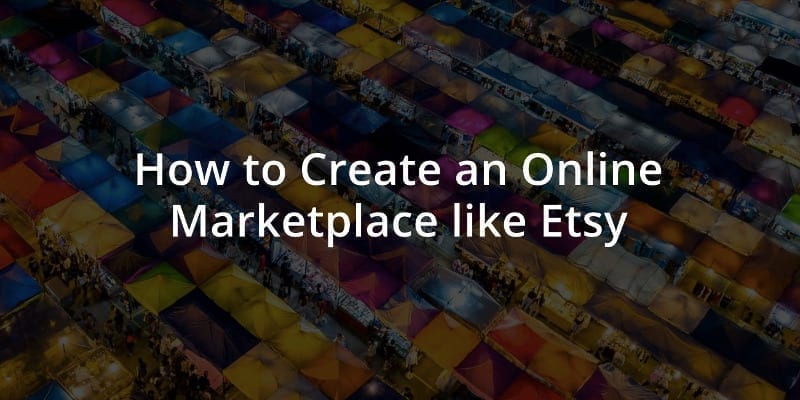How to Create an Online Marketplace like Etsy
The reason behind your decision about building your own multi vendor marketplace website can be very different.
Robert Kalin, Etsy’s founder, wanted an eCommerce platform to sell a wood-encased computer that he crafted. He came up with the multi vendor marketplace website name while watching Fellini’s 8 ½, and coined it from Italian “eh, si”.
Jeff Bezos was totally rational while establishing Amazon with his “regret minimization framework”—a decision he made in order not to miss the e-commerce boom. Though initially, he named his multi vendor marketplace business website “Cadabra”, as in “abra cadabra”. This name went into extinction immediately after his lawyer mistakenly heard “cadaver”.
Driven by different reasons, entrepreneurs created many thriving multi vendor marketplaces and have made the physical product e-commerce industry a highly competitive market for newcomers to step into.
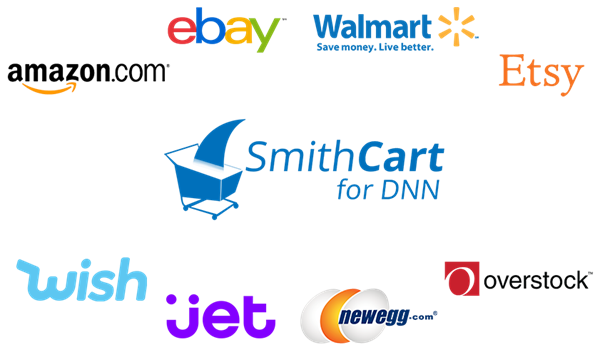
What they probably have in common is the painful ‘things I wish I knew before I started to build a multi vendor marketplace’ learning.
This is your advantage in such a competitive environment—you can build your own marketplace business successfully by learning from the industry trailblazers’ experience.
You may also be interested:
1. Clarify Your Marketplace Idea and Value
So, how to create online marketplace business that will be able to compete with the industry leaders? You need to establish a detailed picture of what positively differentiates you from them—what is the unique value of your web multi vendor marketplace business? Why you want to build an online marketplace business website?
Define your sellers’ and buyers’ expectations, research the industry you are interested in, and check if your idea fits the market.
Understand vendors’ expectations
Survey the audience you are interested in, to understand their expectations better and narrow or segment it later on. Try to embrace all: professional and inexperienced vendors, B2B, B2C, and C2C sellers within the industry that you defined
Detailed understanding of wider audience expectations will help you narrow and segment your audience later, and to adjust your value proposition.
There are some typical sellers’ expectations that you can fit with your virtual marketplace business value:
- additional promotion and extension of their habitual market;
- costs reduction—ability to use your marketplace business infrastructure, functionality, and tools instead of establishing their own platform;
- reduction or improvement of their existing distribution chain (fewer intermediaries);
- for professional sellers—a new potential immense sales channel;
- for newcomers—an opportunity to make the first step, to start their business and gain a wide customer audience;
- the fastest way to reach new customer segments;
- efficient functionality to sell online—in case your online shopping mall provides that: separate online stores for each vendor, search bar for each vendor’s store, and so on.
Understand buyers’ expectations
The following benefits could attract customers to your multi vendor marketplace website:
- confidence and security for online purchases;
- a broad range of products and prices at one place;
- flawless buying experience—smooth payment and delivery processes, convenient goods searching;
- time saved—thanks to the centralization of products and a single shopping cart (if your marketplace website provides that);
- expenditure savings.
Research the market and assess your idea
The chance is great that someone else is already working on the same idea.
There is nothing wrong with that since the execution can turn a similar idea into a completely different marketplace business model.
Research the market and track your competitors’ performance to calibrate your idea and upgrade your value accordingly.
You can use the following checklist to assess your value-market fit:
- Is there an unmet need in your target market?
- What are the problem that your idea solves?
- Whose problem does it solve—who is your target audience?
- How does it solve the problem?
- How is the problem being solved currently?
- Why is your solution better—what value are you going to add?
- Is your target audience already looking for an eCommerce solution to solve that problem?
- Which similar problems are the target audience facing and where do they find a solution?
To fill out the checklist, you can conduct a market research, surveys, or one-on-one interviews—what’s important is to define and address a right target audience.
With your clients’ expectations’ data, results of the market research, and understanding of your idea-market fit, you can document two value propositions for both buyers and sellers for later use.
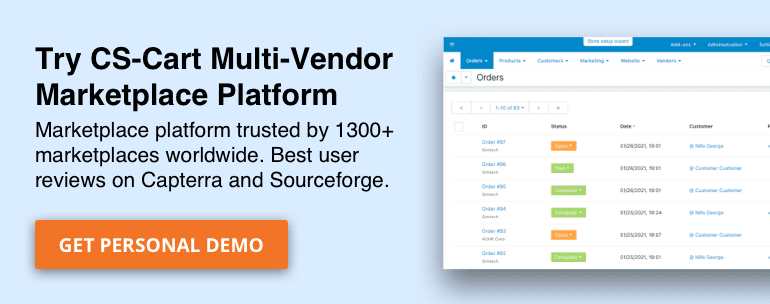
True Experience #1

Annette Ringeisen, the founder and owner of a young but promising handcrafted items marketplace website Cloth&Twine: “You don’t have to blow out someone else’s candles for your light to shine.”
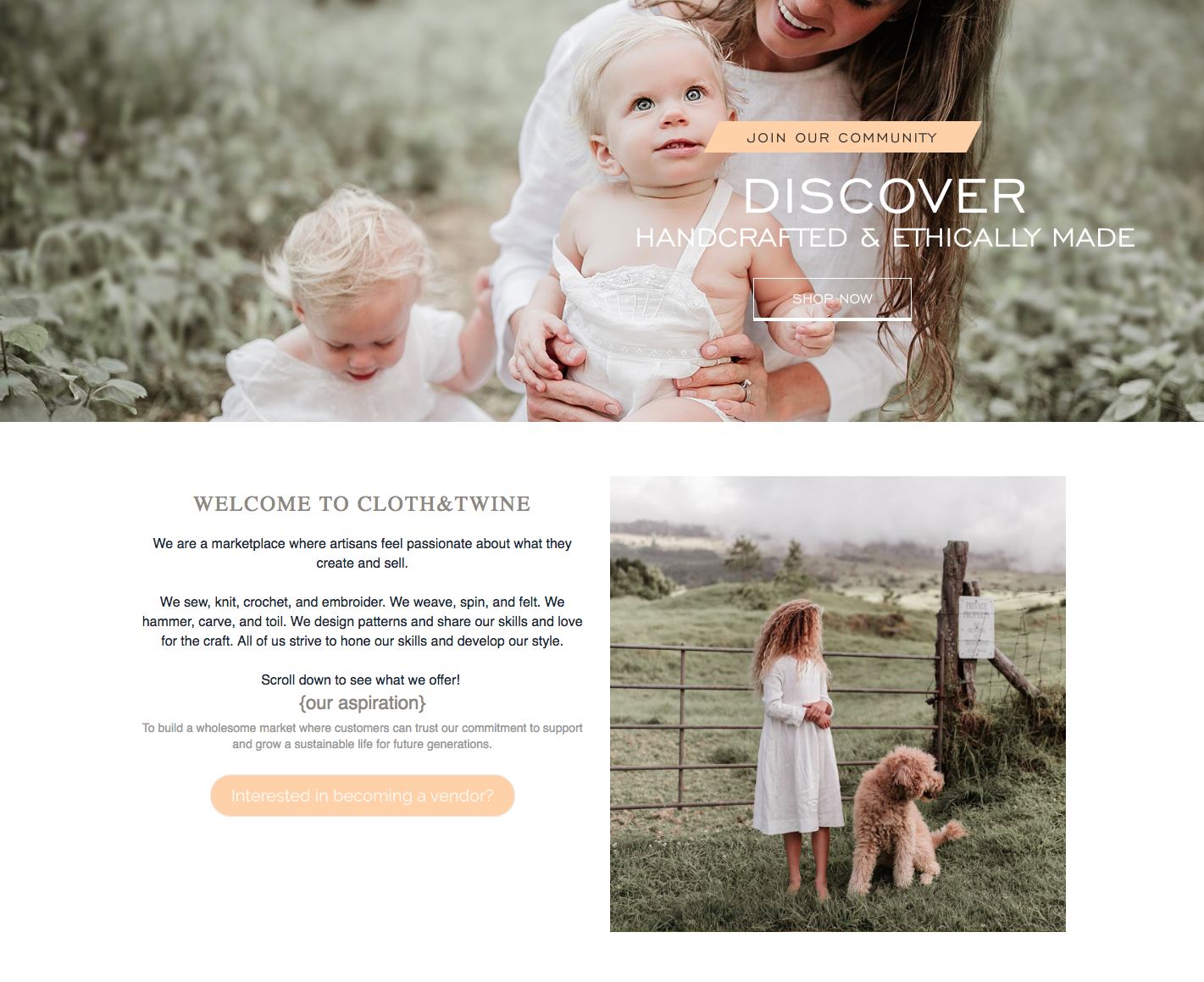
Hello, Annette! Right now you are building your own eCommerce marketplace business that’s opening on May 19, 2018. Share your fresh experience with our readers, please.
Annette, what are the most important aspects a future multi vendor marketplace owner must keep in mind before building the business?
There are so many aspects of building an online marketplace business that need consideration. Some of them you can predict prior to building and others you simply learn along the way. This process will always be part of being an entrepreneur. I would say that the key to it is drawing out a plan and being very clear on the structure of your multi vendor marketplace website. The vision you have for it and the future you plan to create not just for your store, but those who join the marketplace business as sellers, as well as those future customers that will be using it to find their favourite pieces.
Another piece of advice that I would love to pass on is to invest plenty of time to research the platform you’ll be using. There are a lot of choices out there in today’s world, many designed for single-seller online stores, with plenty of apps to plug in that promises the ease of building a multi-vendor marketplace business. One of the harder parts of this journey was finding the right platform that was designed 100% for a multi-seller market, one that understands the essential needs of organization, user-, and room for future growths. I’m excited to be using the CS-Cart Multi-Vendor software and with over 1,300 marketplace websites built with it worldwide, being the most popular solution they sure know what they are doing!
What is more challenging to start—a multi vendor marketplace website or a traditional single-seller store?
Having done both, I would say that there is much more of challenging in building a marketplace business website. With a single-seller store, I was able to bring the vision and products I had in mind to life by putting in the work. Regardless of what I work on, I become quite passionate about it and will work endlessly until it’s complete. Building a multi-seller store is entirely different as it requires me to lead the idea and concept not just for myself, but for those that are part of this new venture. It means keeping everyone updated on progress, launch dates, and collaborating with many different types of creatives at once to make this marketplace successful.
Although it’s certainly more work in terms of building a multi vendor marketplace business, it’s even more exciting because it’s also building a community of creatives that have joined together with the same vision.
You can ask any creative business owner, and they will tell you that although they consider their job the best in the world, doing what they love, it can be lonely at times. My goal with this isn’t just building the most defined marketplace business of ethically handmade pieces from around the world, building a community around the markets. A place where we can all come together and grow.
Do the marketplace website storefront design and navigation matter at the start?
Beautiful designs and user-friendly site navigation is incredibly essential in building strong. Web design is something I also enjoy, and it’s helped me piece together my storefront design. As far as investing in a unique design or spending that budget elsewhere I believe that the best businesses out there don’t use unique branding as the backbone of their business, they use the products they sell, the pieces that truly define what their company is all about. I’ll always strive to have a beautiful, user-friendly website, but I do not feel the need to hire a designer to create a unique one of a kind brand and store design for my marketplace business website because this business is so much more than just a layout.
My advice would be to find a theme you love, as there are some incredible affordable pre-made themes available and use this as your platform to display your products. As long as you have a unique idea, with unique products, a clean, organized theme will do the job.
It’s also important to keep in mind that where you start, is not where you will end. Throughout the years you’ll make adjustments, you’ll grow, you’ll change your design, and as you’re moving forward in the right direction, all aspects of your business will improve with it, including your store-front design. The goal of running a successful business is not to have it all figured out on day one; this is simply where we start.
How to stand out from your competitor marketplaces and fight giants like eBay and Etsy?
It’s easy to stand out when you’re willing to stand alone. We believe places like eBay and Etsy, which all started out small at some point in time have a wonderful place in today’s economy. They serve a purpose, and we have no desire to replace them or become them. We have a very defined vision for our company, one of them is ensuring that all pieces sold on our marketplace business are truly handmade by creatives from around the world. Something no other multi vendor marketplace website is genuinely doing. It is the core of our business and it’s what makes our company unique from anything else you’ll find out there.
We are a marketplace business where artisans feel passionate about what they create and sell. We sew, knit, crochet, and embroider. We weave, spin, and felt. We hammer, carve and toil. We design patterns and share our skills and love for the craft. All of us strive to hone our skills and develop our style.
The beautiful thing about unique ideas is that you eliminate the worry of competition, as a business owner myself, I applaud all other businesses, small or big and believe there is enough room for everyone.
“You don’t have to blow out someone else’s candles for your light to shine.”
We have some great marketing and advertising plans ahead to get our shop sellers in front of the best potential customers and are beyond excited to help hundreds of small businesses reach new levels for their business.
2. Choose the Right Business Model
Everything from user experience policies and commission model, to the overall multi store eCommerce platform functionality and tools are based on your marketplace business model.
Tune your focus
Narrow down or segment sellers to customize your value proposition:
- Business To Consumer vendors (B2C);
- Consumer To Consumer sellers (C2C);
- Non-professional sellers (craftsmen, artisans);
- Professional sellers (traders, suppliers).
Choose a monetization model
There are plenty amount of revenue models that best fit a physical product marketplace website.
Commission—a rate per transaction. For a physical product shopping mall with a wide goods’ selection, commission is usually small. For a specific vertical marketplace, it can be higher.
Subscription—a paid subscription for different sellers’ categories established on the basis of their sales volume and other criteria. Subscription gives vendors particular benefits—promoted listings or free advertising within a multi vendor marketplace business.
Promoted listings on Etsy:
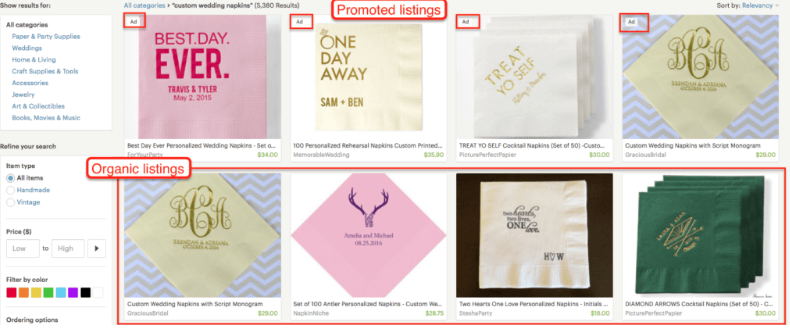
Freemium—revenue flow comes from additional services and value-added features for sellers: advertising, shipping labels, ability to send special offers to shoppers, and many others.
Listing Fee—the best fit for vendors who sell only a part of their catalog, and is active at some particular time of the year.
Etsy uses this fee option as an affordable model to encourage new sellers:

In case your seller crowd is a very diverse one, you can establish different commission models that are suitable for each segment.
Etsy adopted this approach by mixing existing fee types and creating new ones:
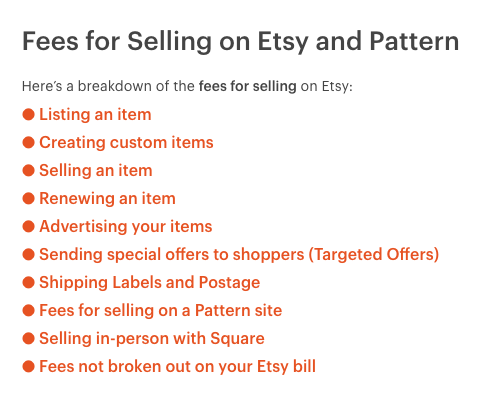
Select a CMS to set up a marketplace website
A content management system is one of the most crucial marketplace business elements to consider when thinking about how to create online marketplace website.
Your daily operations and transactions, speed of work, amount and variety of tools available for vendors and customers fully depend on cms.
A good multi store eCommerce platform can provide all the functionality you need to attract even well-established vendors and customers to your marketplace—from various payment options, to the ability to set up a separate online shop for each vendor.Research functionality and price.
Usually, you need to add a huge part of functionality and tools to a marketplace website long after it starts working.
That’s why you should define which tools and features you’ll need when the number of items, customers, and sellers’ expectations will increase. Then compare cms different prices and functionality in that context.
Free solutions will enable only limited functionality, which needs to be expanded soon, and often, it’ll cost much more than the initial package of a chargeable cms.
Heather Noss, a seller from Etsy, is a good example of how you can lose the best vendor due to a limited multi vendor ecommerce platform functionality.
She was building a shop on the marketplace website for quite some time, but due to her business growth, she needed tools that weren’t present at the shopping mall. She set up another channel, and now, 80 percent of her revenue comes to her directly, and only 20 percent—through Etsy.
Thus, a good move is to make some investments upfront, to save on the long-run and get a quality ecommerce solution intended to satisfy all the needs of your sellers.
From the other hand, you shouldn’t pay just for a well-established brand.
The best way to avoid that is by running a trial period. Find multi store platforms that offer full functionality during a free trial period, try it yourself, and make an informed conclusion.

True Experience #2

Gaurav Gupta, Director at Onjection Labs—eCommerce store and marketplace development company: it really gets tough once you have a few hundreds of vendors selling their products

Hello, Gaurav! 4 questions for you:
1. What are the most important things an entrepreneur must keep in mind before building a multi vendor marketplace website?
How to create marketplace website? Start from something niche and find out about the target audience that you will serve. And in a multi vendor marketplace, you will be having 2 set of customers. Those who are actually purchasing the products and the sellers who are putting up the products on your website. You need to keep a balance between both and focus on both in order to get the business going. Don’t start with fighting out the big ones, instead create your own community.
2. Is building a marketplace website more challenging than building a traditional single-seller online store? Why is it so?
Yes, its a much more complex game. There are lot of things that you need to take care of:
- The message to customers should be clear
- You need to have a very solid backend system
- Vendor KYCs
- Product portfolio management
- Shipping automation
- Vendor payouts
- And the most important part is accounting, you need to start investing in it from day one. Because in a multivendor eCommerce store it really gets tough once you have a few hundreds of vendors selling their products.
3. Does the marketplace website storefront design matter at the start? Should an entrepreneur invest in unique design or spend the budget on more important things?
Yes, it matters, not that it should be very much attractive, but it should give the right message to the customer. Say you are building a b2b multi vendor marketplace or a b2c multi vendor marketplace business, whether you are going to sell digital products or physical goods. If its a niche category, whether you are a horizontal marketplace or a vertical marketplace, it should reflect in your design. But this can be done by spending less and keeping it more simple.
However the real ecommerce is how you manage it, how you execute it, which is your backend system. You can get website similar to Ebay and Etsy, but what differentiates them from the rest of the world is how they execute their business. Real ecommerce is at the backend.
4. How to stand out from your competitor marketplaces and fight giants like eBay and Etsy at the start?
To fight the giants like Ebay and Etsy you need to have similar budgets like them, plus they have evolved over the time. So it’s not that easy. Instead of fighting them, you should find your target audience and try to serve them in a better way as compared to the competitors.
In my suggestions you should always start from some niche category and then expand the offerings.
3. Put Your Marketplace into Action
Testing a multi vendor marketplace with early adopters
If you don’t know how to create marketplace website, then just use ready-made marketplace business solutions. Testing the initial marketplace website version with early adopters, a small segment of your target audience, is the initial stage after the multi vendor marketplace building stage.
After a short period of usage, they’ll provide feedback about the necessary improvements that you need to polish for a bigger crowd to come.
Further development
There are two things to concentrate on for further development:
- the value communication
- the tools and features proposed to sellers and buyers
The value communication. Communicate your value through design and wording to attract customers at a large scale and create a community of like-minded evangelists around your virtual shopping mall.
Etsy’s site is to create a feeling of trust between online vendors and customers and fits customers’ lifestyle while the wording highlights the value proposition:
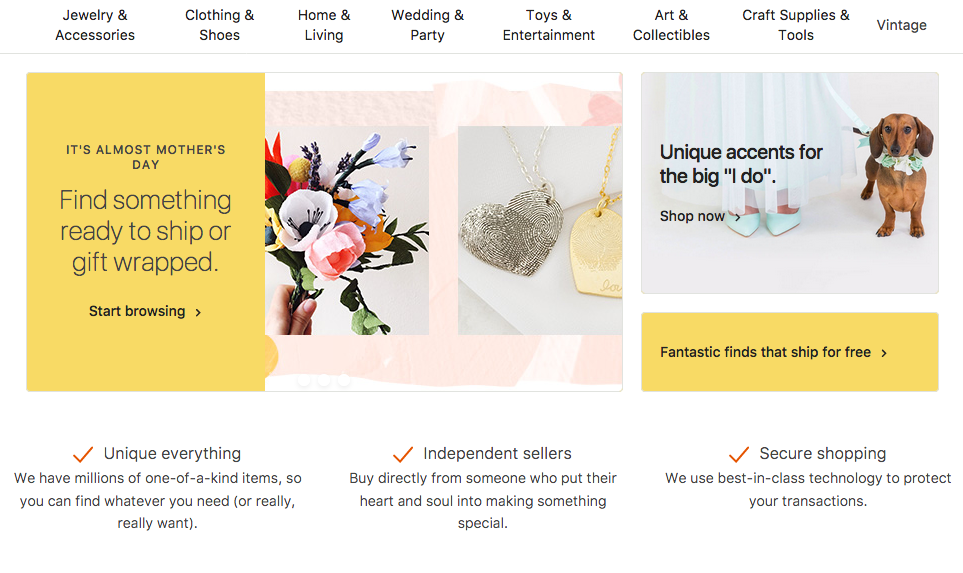
CleverLittleMonkey, a “parents to parents” online marketplace business that sells baby furniture is a great example of value communication:

Everything including the colors and stunning pictures reflects the ecommerce marketplace business and its audience shared-values—comfortable furniture and design for kids:

For a shopping mall with various sellers that want to communicate a unique product idea, the best way would be to provide each vendor with its own store.
If your ecommerce cms allows you to do that together with other tools to help sellers to establish their own brand and build a strong connection with their customers, then this would be a strong argument for them to come at your online shopping mall and stay for long.
The tools and marketplace website features proposed to sellers and buyers. To convince well-established sellers to stay in your marketplace by just offering them a personalized shop window isn’t enough.
Give strong tools in their hands to show how they can boost income in your online shopping mall.
A great example of that is Mode, an online fashion marketplace business with the products from New Zealand based fashion boutiques.
To acquire and retain vendors, the online marketplace provides separate web stores for each seller:
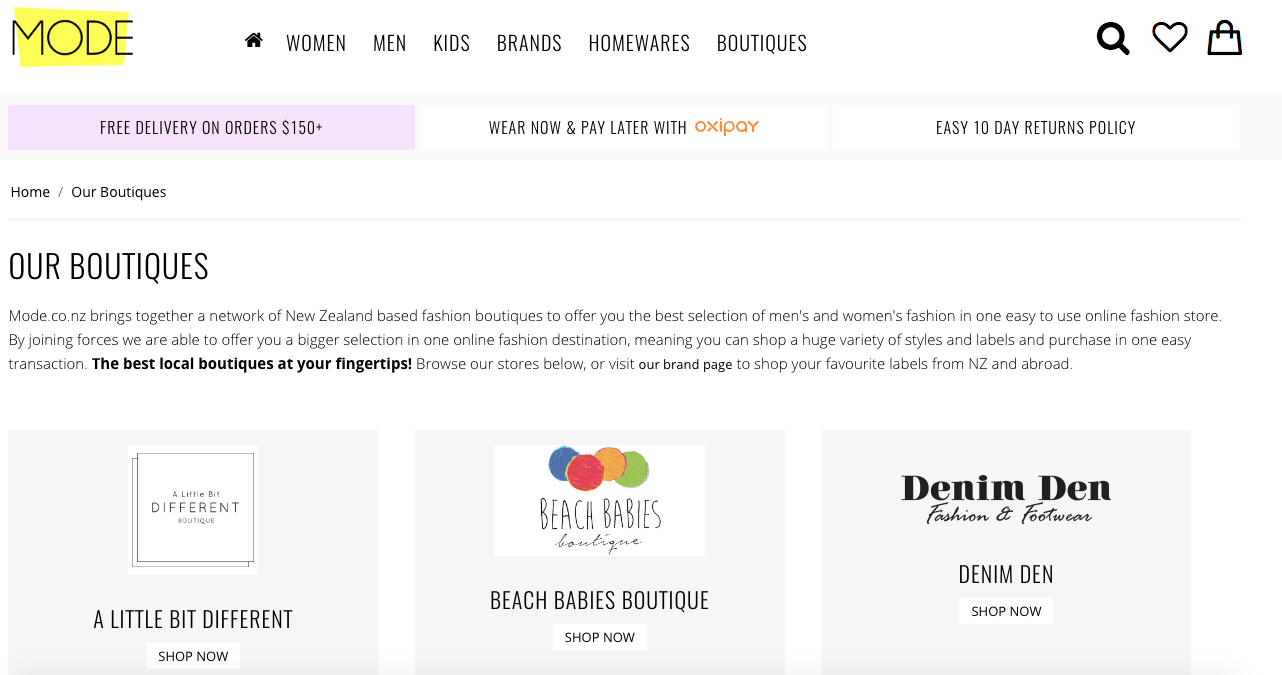
Moreover, they help vendors raise their sales by providing them an advanced search system. Sellers have not only product filters, but their own search engine to help customers find items at each vendor’s shop.
This enables a flawless discovery process for customers as well:
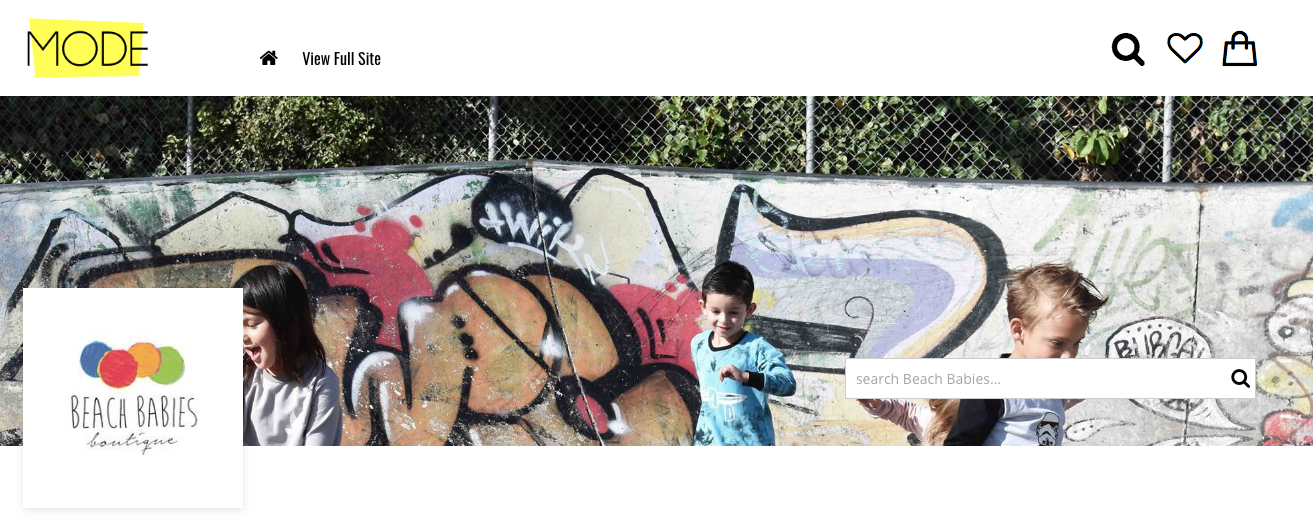
Finding first clients
Start acquiring the first sellers to build an attractive offer for your Internet marketplace buyers when they come.
Existing sellers—contact vendors that are already active in similar web marketplaces and other relevant online platforms like social media and communities.
Potential sellers—use online and offline resources to connect with them: business directories and aggregators, hobby clubs, networking groups, trade associations, online forums, offline stores and workshops.
To find customers, collect email addresses of potential buyers before building a marketplace business, using pre-launch campaigns and landing pages.
Understand who your potential early adopter customers are, and where they hang out online and offline:
- existing communities—join the group and participate in the discussions, mentioning your marketplace platform model and asking for feedback;
- major community influencers—convince well-known bloggers to advertise the shopping mall to their audiences;
- consider building your own community through a blog, social media or a forum, and host offline meetups or events.
Use a Bullseye Framework to pick and mix right strategies to get traction for your multi seller marketplace:
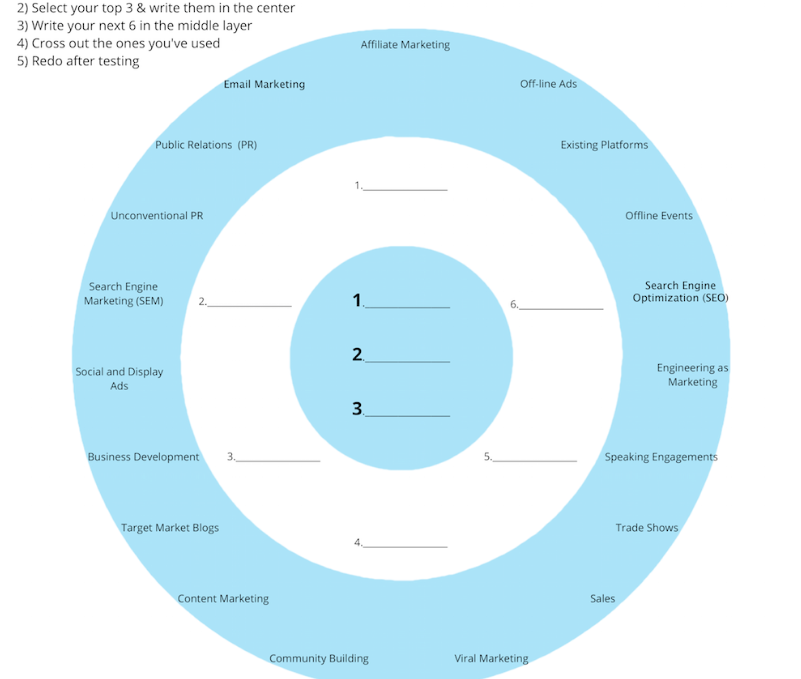
Сheck the practical ideas of how to mix customer acquisition techniques for shopping malls on our How to Promote an E-commerce Marketplace blog post.

True Experience #3

Hugo Smoter, CCO of Spreadshirt, the self-expression global e-commerce marketplace business, shares strategic tips on how to create a marketplace business and how to create marketplace website.
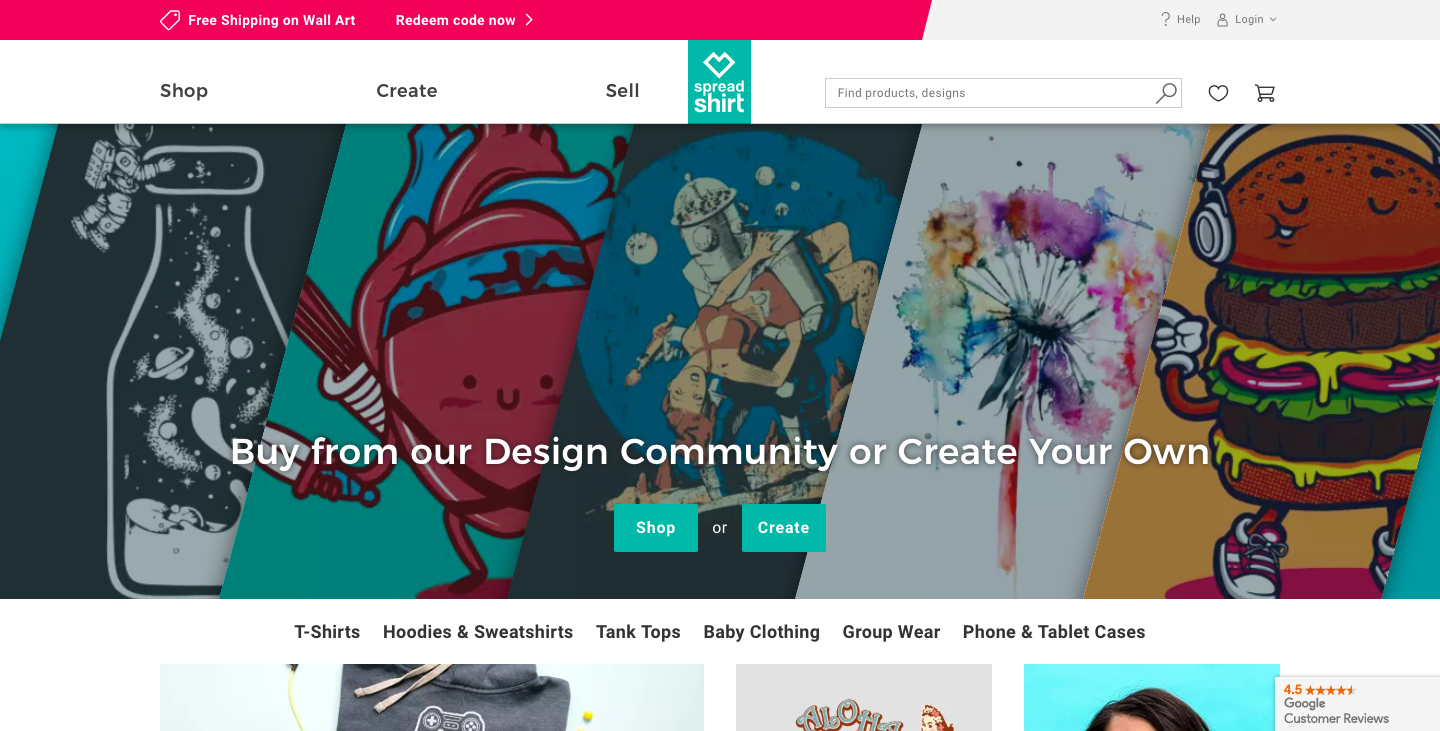
Spreadshirt’s three approaches—create-your-own, marketplace, and shops—provide limitless opportunity for on-person self-expression. As a platform for self-expression, Spreadshirt empowers people to express themselves through creating, discovering, and selling clothing and accessories with messages they want the world to hear.
Founded in 2002, Spreadshirt is available in 12 languages, operates five global production sites and ships to over 150 countries. In 2016, it hit global revenue of $102 million, printed more than 4.1 million items, and had over 70,000 selling partners.
Becoming a shop owner with Spreadshirt is more than just a second source of income, it gives you the opportunity to call the shots and to be your own boss. Whether you have your own business or you consider building one, you’re not going to have time for production, fulfillment and shipping. Our shop system is built around the needs of self-starters and go-getters. We take the hassle out of merchandising, so you can focus on what’s important for your brand.
If you select the right multi seller ecommerce platform with global reach, online merchandising can be easy with no overhead costs, worries about shipping, currency exchanges, or tax logistics.
Companies like Snapchat, Facebook, Twitter, and YouTube enable self-expression in the digital world but people don’t have the same opportunities in the real world where the need still exists. Spreadshirt gives that opportunity.
Commission: How much am I earning?
It’s important to educate yourself on the commission models that the different host sites offer before deciding which platform you’re going to sell your products through—after all, at the end of the day you want to be earning the most you can from all of your hard work. Here at Spreadshirt, we recognize that the shop owner is the creative force behind the sales. That’s why we offer the highest commission opportunities in the industry. With an automatic 20% commission, your earnings can increase to 60% commission when more products are sold. You also get to set your own design price, and keep 100% of the profits!
Promote, Promote, Promote
Sales won’t just come on their own—your audience will want to know about your brand before they purchase anything. Between social media, blogging, SEO, and Facebook ads, there are countless marketing opportunities for your shop. Shop owners nowadays can choose from a huge variety of image-based mediums, such as Pinterest, Instagram, Tumblr and more. Some shop owners are now also incorporating video-based platforms into their marketing strategies, such as YouTube, due to their videos being incorporated into Google’s search results.
Don’t Diss the Promo
For many web shop owners, the term “promo” immediately translates to “less money” and sets off alarm bells in their heads. But we have to disagree here—discounts and promos can only help your online shop grow. You may be skeptical about the financial benefits of a promo, but you’d be surprised to learn that many buyers rely on these discounts. In fact, up to 50% of consumers admitted that they only make a purchase when there’s a discount!
4. From the Initial Success to a Stable Growth
The following priorities are the main drivers of your marketplace constant development on a long run.
Newcomers support
Inexperienced sellers are a huge potential for your multi vendor marketplace. They gain their first success with your daily support, turning into your most dedicated advocates, which can bring you huge benefits.
For example, dedicated sellers of Etsy’s marketplace initiated and implemented a campaign on Twitter that brought extra attention to the site.
To continue building such a community, Etsy holds various events and activities.
“Etsy Craft Entrepreneurship Workshops”:

Besides, the marketplace has a workspace that provides equipment and materials for a shopping mall users to create items and attend workshops and events:

Focus on repeat purchases
Etsy’s constant priority is to boost repeat purchases.
This strategy is exactly what brought the virtual shopping center to the top. It’s obvious from the marketplace S1 metric of Gross Merchandise Sales contribution by first-time buyers and repeat purchases:
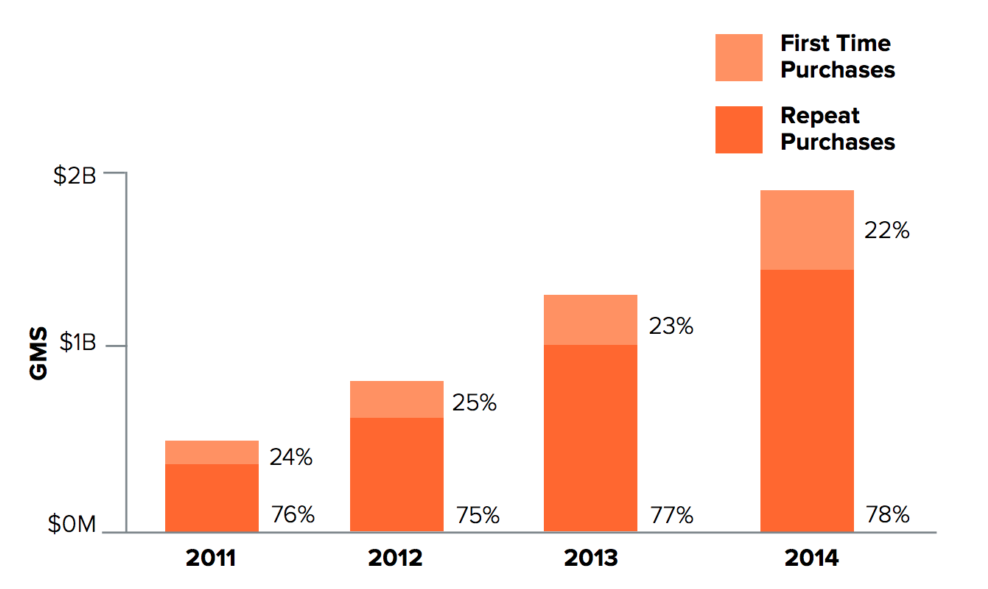
Customer service
The main hallmark of Amazon, in the beginning, was its obsession with customer service.
Keeping up with this approach helps Amazon stay on top.
The marketplace’s Prime subscription, which contains a huge amount of benefits and perks for clients, brings customer service at the new level, and clients appreciate that—one out of every four homes uses this subscription:
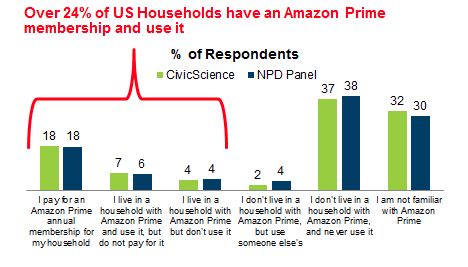
New tools and functionality
In Etsy’s first year, it attracted attention for adding new tools and functionality to help sellers gain exposure and traffic. This approach defined the success of the multi store marketplace.
Its plan for the next year shows that Etsy still adheres to this strategy: the company focuses on four things: search and discovery, trust and reliability, marketing capabilities, and seller tools.
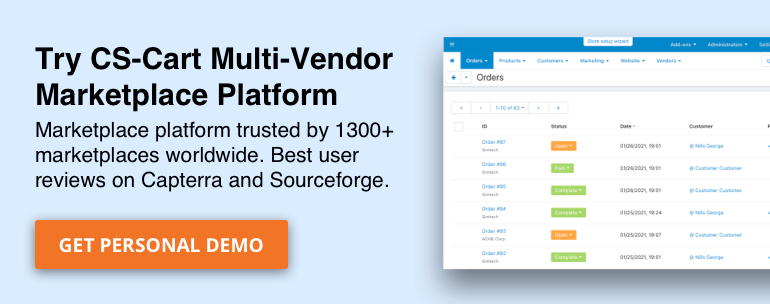
True Experience #4

Krista Fabregas, E-commerce Analyst for FitSmallBusiness based in the New York City, points out milestones in building an eCommerce multi-vendor marketplace

A multivendor marketplace can be far easier in terms of building and operation than an end-to-end online store. Multivendor marketplaces are quite simple to start, thanks to dedicated marketplace platforms such as Mirakl, CS-Cart Multi-Vendor, ShareTribe, Marketplacer, and WordPress plugins WC Marketplace, Dokan, and many others. These platforms give marketplace publishers a ready set of back-end third-party seller tools, secure checkout, integrations to aggregate payment processors, and a clean front-end multivendor storefront presentation and navigation.
Since the technology is readily available, even a moderately tech-savvy publisher can initiate building of a multi seller marketplace within a few days. Once the building stage is finished, the real job of the marketplace publisher is to market the overall concept and create buzz that attracts both sellers and shoppers.
Once it starts attracting an audience, it’s the third-party sellers who do the heavy lifting by sourcing or making goods, managing inventories, populating the shopping mall with product listings, and shipping orders. At that point, the publisher just needs to maintain the site technology, ensure sellers are meeting the marketplace’s standards and keeping customers satisfied, maintain scheduled payouts, and deal with issues that invariably crop up. These are not small tasks, but they tend to be less cumbersome than running an end-to-end fulfillment operation.
If you use a ready-made marketplace solution, your multi store ecommerce platform provider walks you through all of the technical bells-and-whistles, so that part is easy. Beyond that, you need to set up of third-party seller rules and customer service expectations. Remember, if things go wrong, it’s the marketplace’s name the shopper remembers, not the individual seller. Marketplace platforms typically track seller performance for you, and you can make tasks like shipping easier on your sellers by incorporating seller-accessible shipping tools into your platform.
Managing aggregate payments and seller payouts is another consideration. Stripe and PayPal both offer marketplace and multi-seller payment management tools. Most marketplace seller platforms integrate with one or both. And, again, multi vendor platforms walk you through the process of selecting a payment integration, setting your fee percentage holdbacks, payout schedules, and handling refunds.
Budding marketplace sellers also need a sound marketing plan that includes targeting social media within their niche, identifying and courting influencers, and email marketing. Ongoing roundups of daily or weekly deals are effective in touting all that your shopping mall sellers have to offer.
And don’t forget the content aspect. Content sections that share ideas related to the focus of the marketplace are a great community-builder that promotes continued engagement from both sellers and shoppers. Encouraging sellers to help you populate content sections with perks, like seller badges or lower fees, helps build content sections with little effort.
Niche marketplaces are where most startup publishers find success. A startup is not going to outshine Etsy or Amazon, but it can do a better job serving a unique market, unlike the marketplace giants. A good formula is targeting a niche, be it knitting, a sport, specific fashions or cooking styles, or even subscription boxes (Cratejoy is a great example of success)—whatever attracts a crowd of sellers and buyers.
Resale marketplaces are gaining popularity, too, so a virtual shopping center with at least a strong resale component is a good place for budding marketplace publishers to start.
True Experience #5

Ninju Narang, CEO at Howzzthat.com—an apparel and accessories marketplace from India—shares a checklist of a multi store ecommerce marketplace that works
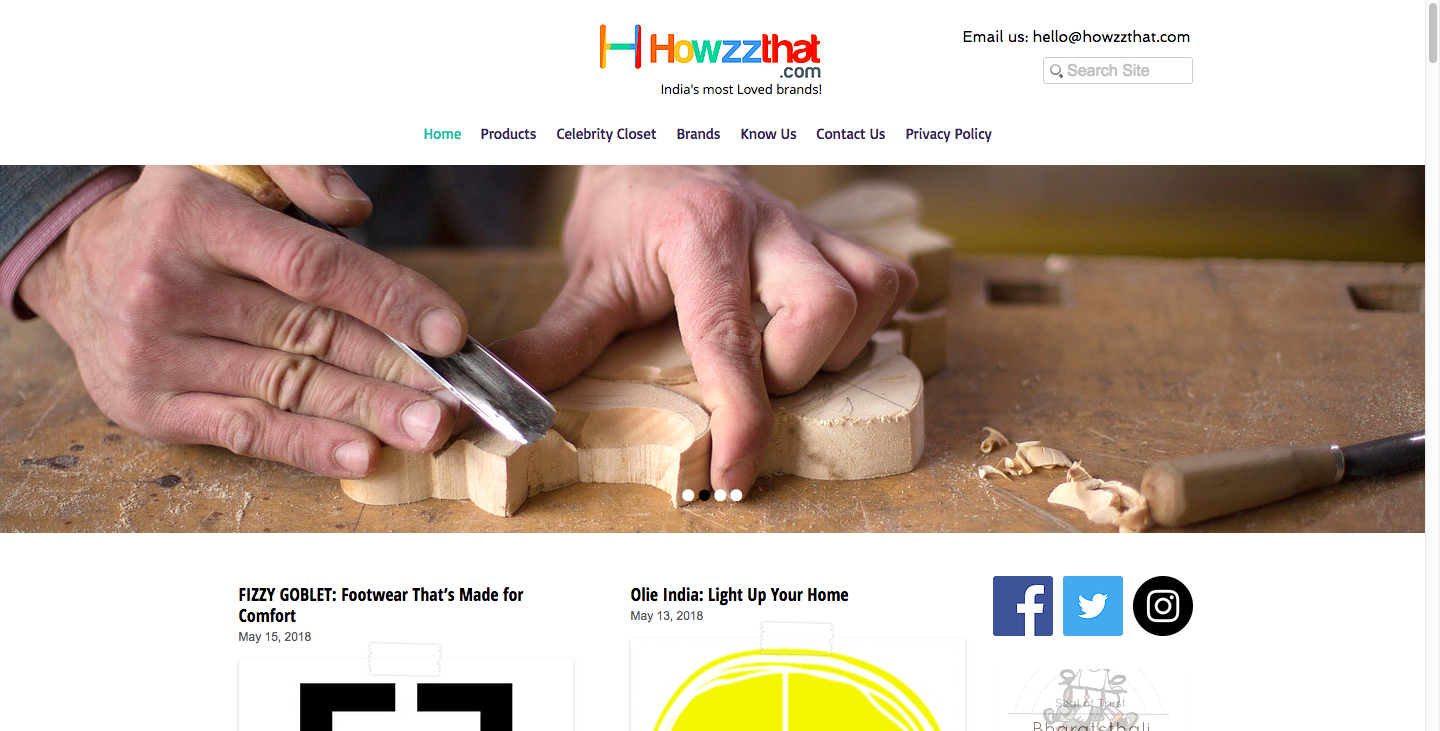
Bill Gurley of Benchmark Capital wrote the definitive post on which markets are the best fit for shopping malls: “All Markets Are Not Created Equal: 10 Factors To Consider When Evaluating Digital Marketplaces.”
Some of the most important factors are:
- High fragmentation. There should be a lot of suppliers and buyers otherwise if there are a few, they would not want to share in the economics (take rate) and are likely to fight the arrival of an intermediary. Apart from that a web marketplace can create the most value in a highly fragmented market where there is a true need to help buyers and suppliers connect with each other.
- The buyer/seller relationship. If buyers are loyal to the supplier they may bypass the marketplace altogether. For example – once you are satisfied with a trainer or doctor or cleaning service there are chances that you may not visit the virtual shopping center again to hire them. Similarly for commoditize products like diapers or raw materials for business.
- High frequency. The higher the frequency of purchase the better it is for the online marketplace. Infrequent purchases make it difficult for the shopping mall to establish a brand.
- Total available market. How big is the available market? And how much can you capture? Specially measure the size based on the value you are creating.
- Transaction being part of the payment flow. The take rate is much higher when the transaction happens on the marketplace online as compared to when it is done offline.
Building a marketplace is easy as unlike an ecommerce store you require less capital to buy, build and manage inventory. And when a marketplace works there is an opportunity for long term profit at scale and once it achieves liquidity it is hard for others to compete.
Counterintuitive to the flavour of the season of starting lean, an online marketplace should spend considerable efforts in the design. As said by Steve Jobs design is not what it looks but what it does. The multi vendor marketplace should be at least at par with similar marketplaces in the market which will help to build and foster consumer confidence and trust.
Any newcomer should focus on the incumbent weakness, which will vary from different situations. Some of them are:
- Lower the take rate. However, it should not be seen in isolation, you need to differentiate with lowering the take rate.
- Go vertical. Take a particular category and develop your expertise and probably you can then expand to new categories later on.
- Develop 10x better product. Off course this opportunities are rare as incumbents network effect outweighs and product improvement.
- Unique inventory. Identify opportunity on the supply side to bring unique inventory. This has certainly benefited Etsy vs eBay.

True Experience #6
Harm Smits, Lead Developer at PoppedWeb—eCommerce company from Netherlands that helps to start up, support, and develop online businesses: “Keep your web marketplace stupid simple.”

The most important thing to know is that there are no shortcuts for building a marketplace and making it successful. Having a sound strategy and knowing best practices are important, but you still need to be prepared to put in lots of hard work to grow your community and make it flourish. You need to grab users’ attention by using unique strategies and making them feel not like a robot, but like a person with actual feelings.
Building an eCommerce marketplace is much more challenging than building a single-seller online store. Building a successful marketplace business takes a lot of work. Coming up with an idea and building a website is just the very beginning. While you don’t need to have your own inventory, you need to solve the chicken and egg problem. Unlike a normal store, you need to convince others to bring their inventory to your shopping mall when there are no buyers yet.
The design matters, of course. When you keep changing your identity you will only confuse customers, which is not exactly what you want to do. You want them to remember you for as long as possible since most people buy again at the same shop (if they are satisfied).
Also, when you start a multi seller marketplace you need to make initial investments, that’s just the way it is. The best things to look out for are the following:
- Server hosting, get a dedicated server and search for a proper hosting company because nobody likes a slow website. If you do not have any technical knowledge you should contact a the platform developers as the speed is not just defined by core count or the amount of RAM.
- Design creation, your identity is what makes you successful. The more people feel like they got personalized service, the higher the chance they will come back.
- Infrastructure, make sure that you can always expand. A good example of this would be ‘AboutYou’ which is the fastest growing shop in a long time.
eBay and Etsy are so large that offering personalized services is next to impossible, therefore the key is in making people feel like they are unique. Furthermore, you can also fight them with regard to functionality. We wouldn’t exactly call eBay the best designed marketplace ever, it has so much information that it is close to impossible for the user to filter through it. Therefore it is recommended to keep it stupid simple. Users nowadays know exactly what they want to buy before they have even visited your marketplace.
True Experience #7

Jaspal Singh Nijjar, founder of the upcoming “Makes Me Healthy” marketplace, gave us a short interview on how to create a marketplace. They are opening it right now and their experience is freshJaspal, what are the most important things an entrepreneur must keep in mind before building an online marketplace?
Building an online marketplace, the entrepreneur needs to make sure they have sellers who have interest in the concept. If sellers have no interest there is no reason to go further. Without a live website, I emailed sellers with a generic email and what we plan to do and how we can help them, and found the replies to be positive which validated the concept to take it forward.
Is building an online marketplace more challenging than building a traditional single-seller online store? Why is it so?
Yes for sure, as you have to deal with both sides, seller and buyer, so it’s the chicken and egg scenario. You need to offer value to both sellers and buyers.
Does the marketplace storefront design matter at the start? Should an entrepreneur invest in unique design or spend the budget on more important things?
Don’t waste too much time on design. Get the idea live and then start to build up the design. You can invest in design, sales, and technology to scale and grow.
How to stand out from your competitor marketplaces and fight giants like eBay and Etsy at the start?
Start with a niche and get some distinctive brandstaing. We have our logo, “Jaspar—the worlds healthiest shopping basket” and we are starting with niche—health products/supplements and then will branch out in the future to other categories related to health—apparel, pet products, sports/fitness goods etc.
~The priorities chosen by the industry leaders are clear: constant focus on flawless customers experience enablement, and sellers education and support.
Concentration on the technical part of a marketplace—tools for vendors, and search engines enhancement shows that the next successful marketplace businesses will be brought to the top by their powerful eCommerce platform’s technical tools and functionality.
So, with all this information in mind, you now know how to build a marketplace website and how to grow it.
Follow us on LinkedIn to get these educational articles right after they go live and other company life news and insights.
Yan Anderson is the Head of Content Marketing at CS-Cart with over 10 years of experience in the eCommerce industry. He's passionate about explaining complicated things in simple terms. Yan has expertise in building, running and growing eCommerce marketplaces. He loves to educate people about best practices, new technologies, and trends in the global eCommerce industry.
